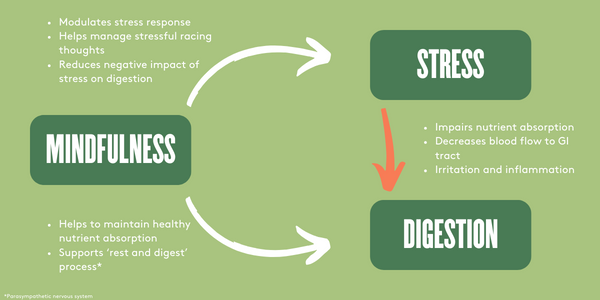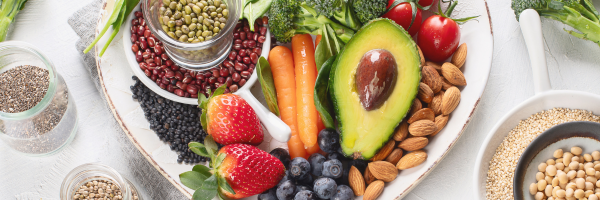When we talk about food, we usually focus on what we’re eating – its nutritional value, how it was made, and how it tastes. But when was the last time you thought about how food makes you feel?
Mindful eating asks you to consider your feelings and thoughts while eating to make you more aware, grounded and empowered about your food choices.
In this app-exclusive guide, we’ll explore the practice of mindful eating, its benefits, and the 5 key steps you can take to be more mindful about food.
What is mindful eating?
Mindful eating is about focusing on how you eat, rather than what you eat. It’s an approach to food which considers paying attention and being mindful of our eating behaviours, environment without any evaluation or judgement. This encourages you to savour your experience with food and make more health-conscious choices with your food selections.
Mindfulness practices, such as mindful eating, are supported by health and wellbeing organisations such as the NHS¹ and the mental health charity Mind².
Benefits of mindful eating
1. Understanding your body's hunger cues
It may seem like an obvious thing to ask how you know you’re hungry. But learning to be aware of hunger signals at different levels of hunger, and understanding certain cravings, can help you make more mindful food choices.
Generally, you want to have a snack or meal when you feel some hunger, but before you start getting irritable (AKA being ‘hangry’) or things like headaches or stomach pain. Waiting too long before eating can make you more likely to rush your food, overeat, or choose food that’s quickly accessible rather than nutritious.
2. Better digestion
Research into mindful eating³ suggests that there is a link between how mindfulness can reduce stress, and how stress impacts digestion. When you're stressed, your body may struggle to absorb nutrients and your gut can get inflamed. So, practicing mindful eating could help support good digestion because of how it reduces stress.
3. Help with weight management
Eating because of emotional cues and being unaware of your fullness signals can both lead to unintentional weight gain. With mindful eating the goal is to only eat when you feel hungry – not because you’re stressed, sad, or bored – and to finish your meal when you feel full, even if there might be food leftover.
But try not to feel down if you do find yourself eating because of your emotions. Practicing mindfulness means acknowledging your feelings and reasons for eating, but using that to become more understanding of yourself, rather than feeling ashamed or guilty. Because in the long-term those feelings of shame may actually worsen your relationship with food.
4. Supporting a healthy, balanced diet
Part of judgement-free mindful eating is not labelling foods as ‘good’ or ‘bad’, or ‘clean’ or ‘junk’. However, practicing mindfulness and focusing on how their body feels after they eat different foods helps some people choose more nutritional, balanced meals.
5. Less stress
When you reduce judgement and shame around food, you may find that you feel less stressed around mealtimes, which reduces some of that everyday stress that we all deal with.
In general, mindfulness has been linked to reduced stress4 because it calms the amygdala – the part of the brain responsible for stress responses. Taking time to be grounded in your body and your environment can take focus away from racing, stressful thoughts and make you feel calmer.
5 Steps To Mindful Eating
1. Listen to your body
As we said, practicing mindful eating can help you understand your hunger/fullness cues. Listen to your body when it’s saying you’re hungry, and again when you feel full.
This can help you feel more connected or grounded to your body which supports general mindfulness, not just around meals.
2. Take your time
Another way to support your digestion is by eating slower, which can also help with mindfulness. When you take your time with food you’re able to focus more on the taste and feel of it, and it’ll be easier to notice when you’re full. Try to avoid eating while distracted or rushed, as this will make it much harder to be mindful.
3. Choose balanced, nutritional foods
You might find with mindful eating that you become more aware of what you’re eating and the nutritional value it has for your body. Eating meals packed with fruits or veggies and lean protein helps us feel energised and satisfied, without the crash that can come from sugary or high-fat foods. But if you do want a sweet treat from time to time, that’s completely fine too!
4. Keep a mindful eating journal
Some people find it useful to write down how they felt during a meal (digitally or on paper) to keep track of which practices or foods led to which feelings. For example, if you switched to eating without the TV on in the background, and that made your meal more satisfying because you weren’t distracted from it. Or if you write the times you had each meal or snack, this could help you build a routine and understand which mealtimes are best for your body.
5. Do what works for you
We’ve provided these first steps as some guidance if you’re new to mindful eating, but they are just suggestions. Try new approaches to find out what works best for you!
Talk to your doctor
This article is for educational purposes only and should not be used as a substitute for medical advice. If you have concerns about your health, including weight, diet and mental wellbeing, then please contact your doctor or other relevant healthcare professional.
Take home message
Mindful eating can help you build a more positive, judgement-free relationship with food, while also supporting your nutrition and mental wellness goals. If you think you might benefit from mindful eating, the steps we’ve suggested here are a great starting point!
If you need inspiration for healthy plant-based meals, check out the recipes on our blog. Every day until 2nd October only on the Myvegan app, we’re giving you delicious recipe ideas for breakfast, lunch and dinner.
References:
1. What is mindfulness? - Mental wellbeing tips - Every Mind Matters. (2023, April 11). Nhs.uk. https://www.nhs.uk/every-mind-matters/mental-wellbeing-tips/what-is-mindfulness/
2. Mind. (2021). About mindfulness. Www.mind.org.uk. https://www.mind.org.uk/information-support/drugs-and-treatments/mindfulness/about-mindfulness/
3. Cherpak, C. E. (2019). Mindful eating: a review of how the stress-digestion-mindfulness triad may modulate and improve gastrointestinal and digestive function. Integrative Medicine: A Clinician’s Journal, 18(4), 48–53.
4. Mineo, L. (2018, April 17). Less stress, clearer thoughts with mindfulness meditation. Harvard Gazette. https://news.harvard.edu/gazette/story/2018/04/less-stress-clearer-thoughts-with-mindfulness-meditation/




